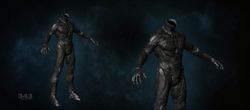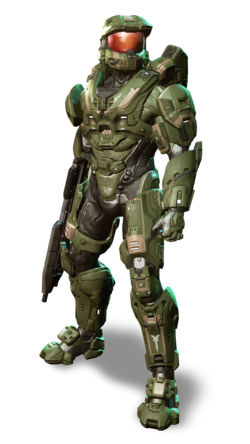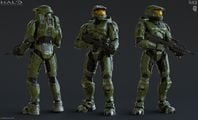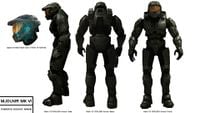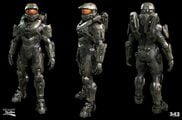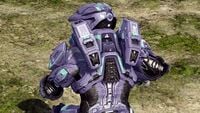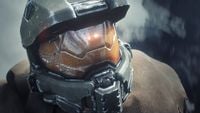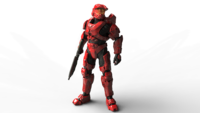MJOLNIR Powered Assault Armor/Mark VI
From Halopedia, the Halo wiki
- "Once he gets a hold of this armor, I think we'll all start sleeping a little better at night."
- — Maria-062[1]
The MJOLNIR Powered Assault Armor/Mark VI was the third major version of the MJOLNIR Powered Assault Armor. The last mainline MJOLNIR GEN1 suit to be widely issued,[2] the Mark VI was issued to the few surviving Spartan-II supersoldiers in October 2552, replacing the Mark V. Shortly after the end of the Human-Covenant War, it was replaced by the Mark VII[3] and MJOLNIR [GEN2]. The Mark VI could still be requisitioned by Spartan-IV personnel as late as February 2558, albeit upgraded to function with the GEN2 suite.[4][2][5][6]
Overview
Late into the war, as work on the MJOLNIR Mark V was being completed, a top-secret parallel development lab in Songnam, Korea, began work on their own prototype of Project: MJOLNIR. This project came to be known as MJOLNIR: BLACK, a standalone "skunkworks" prototype of the Mark VI MJOLNIR armor.[7] Using data from the existing and in-development versions of the MJOLNIR armor, the Seongnam team was able to produce a suit with many technical advancements not yet available to the standard Mjolnir system. After extensive testing of prototype models in combat against the Covenant, the BLACK prototype was eventually inducted into the Mjolnir line and officially designated as the sixth version.[8] It was approved for use after the loss of Reach and equipped to the surviving Spartan-IIs after their arrival on Earth.
The Mark VI is capable of taking full advantage of the physical capabilities of a Spartan. The suit is constructed in overlapping layers. It is environmentally sealed, capable of extra-vehicular activity and operations in toxic atmosphere. It is hardened against electromagnetic pulses and radiation, and has filters that are effective at removing toxins and bacteria from the local atmosphere.[9]
The armor's shell is composed of a multilayer alloy of remarkable strength and has been augmented with a refractive coating capable of dispersing a limited number of impacts from Covenant energy weapons. The suit contains a gel-filled layer underneath a thick black armored bodysuit. The gel layer regulates temperature and can reactively change its density. The inner skinsuit is made of a moisture-absorbing synthetic material linked to an environment control computer and the occupant's neural interface.
Spartans are implanted with a unique model of the command neural interface. This network translates electrochemical signals to digital code and routes them through an interface connection at the rear of the skull. Through this interface, the user's thoughts command the armor's movement and use of weapons, and input from the onboard sensors comes directly to the user's mind. The synthesis of machine and mind is so fast that it is almost impossible to chart reaction time.
Each suit of Mjolnir Mark VI armor contains a layer of superconducting computer memory. Envisioned by Dr. Catherine Halsey, this revolutionary layer forms a network, capable of supporting the kinds of artificial intelligence usually reserved for starships, a piggyback system.
The suits also contain a strength-enhancing layer. This marvel of engineering uses piezoelectric properties to enhance and assist a Spartan's already prodigious muscle power, and grant superhuman feats of might.
The Mark VI largely solves problems with the previous versions of Mjolnir armor. It has an improved energy shielding system, powered by a smaller fusion pack on the wearer's back. This shield system is much stronger and charges more quickly than the Mark V's. The suit also has denser yet less bulky armor plating. These streamlined plates have fewer grapple points than the Mark V so that an enemy has fewer advantages in close combat.[10]
In addition, the Mark VI's liquid crystal and hydrostatic gel layers received significant improvements over the previous version. The liquid crystal layer increases the strength of the armor by a factor of five in addition to amplifying the user's reaction time by the same factor.[11] The hydrostatic layer features a lock-down device, which protects the muscles and joints of its Spartan wearer from heavy-impact injuries.[12]
In addition to major component upgrades the Mark VI introduce a number of smaller technical improvements to components, these included recoil-compensating actuators which handle weapon feedback, as a Spartan is firing a weapon in combat these actuators handle a weapons recoil reducing it without affecting the performance of the Spartan user. The Mark VI also possesses an improved computer system which continuously monitors weapons, biological functions, and motion through intelligent motion tracker.
The third stage in the MJOLNIR evolution, the Mjolnir Mark VI is a fully neural-linked system. With an onboard artificial intelligence using the human mind for parallel processing, the SPARTAN-II/MJOLNIR combination was the most devastating intelligence tool ever created.
Variants and compatibility
Being a modular armor system, Mjolnir can fulfill multiple combat roles and operate in various environments. A number of variants have been designed for to meet the mission requirements and situations. These variants are the pinnacle of Mjolnir evolution from design and function gathered from data, feedback, incidents and general design improvements gather throughout the Human-Covenant War.
CQB variant
- Main article: MJOLNIR/C variant
The "C" variant is designed specifically for close combat by making joints more mobile and including additional attachments for additional close quarters equipment.
EVA variant
- Main article: MJOLNIR/V variant
The "V" variant is designed specifically for extra-vehicular combat. It has more rounded features and improved armor plating that self-seals, securing its user from almost any punctures created by small shrapnel.
EOD variant
- Main article: MJOLNIR/EOD variant
The EOD armor is designed for situations involving explosive material, for example defusing bombs or removing land mines. The modifications to the armor are designed to limit damage to the wearer in a blast.
Recon variant
- Main article: MJOLNIR/R variant
The Scout and Recon projects were run as parallel projects intended to develop a single variant of the Mjolnir armor with stealth capabilities. Recon reduces infrared signature, reflective surfaces, and Cherenkov emission.
Rogue variant
- Main article: MJOLNIR/A variant
When the Outer Colonies fell to the Covenant, the UNSC turned to the private sector to produce classified war military hardware. The "A" variant, colloquially known as "Rogue", is one of several armor sets made by private companies, a trend that would become standard with GEN2.
Scout variant
- Main article: MJOLNIR/S variant
The Scout and Recon projects were run as parallel projects intended to develop a single variant of the MJOLNIR armor with stealth capabilities. Scout relies heavily on highly advanced materials.
Security variant
- Main article: MJOLNIR/M variant
Designed for security personnel, the Security variant was first manufactured on Mars in 2528 and like many other Mjolnir variants, was upgraded to function with the Mark VI suite.
Some Mark VI variants are superficially similar to the GEN2 Mjolnir armor introduced in the wake of the Human-Covenant War.[13] The Mark VI Mjolnir armor worn by MCPO John-117 following the end of the Human-Covenant War was heavily upgraded by UNSC AI Cortana during his five years of cryosleep aboard the UNSC Forward Unto Dawn. Cortana used nanomachines to overhaul John's armor plating.[14][15] She also rewrote the suit's firmware, altering the HUD as well as improving the suit's shield-recharge rate and its compatibility with Covenant and Forerunner armor plugins.[16]
By October 20, 2552, Linda-058 and Fred-104 of Blue Team had been issued variants of Mjolnir Mark VI armor with base components similar to John-117's modified armor.[17] Fred wore the prototype Centurion platform while Linda's variant was custom-built according to her personal requirements, stocked with various attachments and additional optics to make her sniper firing much easier.[18] Kelly-087 also received similar armor after she returned to Earth from Shield World 006 in 2553.[19]
Centurion variant
- Main article: MJOLNIR/Centurion
The Centurion armor successfully went through many field tests following its development in 2552. It contains multiple prototype elements that would later form the basis of the GEN2 platform. Fred-104 was appointed as its tester.[13]
Compatibility with [GEN2] system
Following the development of the GEN2 Mjolnir in the wake of the Human-Covenant War, the external components of the original Mark VI armor were reproduced as a variant of the new generation. The GEN2 Mark VI incorporates slight modifications to accommodate the different base architecture of the GEN2 system.
Armor components
- Inner skinsuit: The inner skinsuit is made of a moisture-absorbing synthetic material linked to an environmental control computer and the occupant's neural interface. It controls the suit's temperature and actively changes how the suit fits the user.[20]
- Integrated communications helmet:[21][22] The ICH is one of the most vital aspects of the MJOLNIR system. It is made of Titanium, contains key features like a Heads Up Display, and can identify equipment and display information about it when it is picked up by the wearer. Another feature is the direct neural interface system, which connects to a Spartan's neural implants. Two core processor chips are implanted into the subjects skull in the rear of the head. This is essentially comparable to an on board computer using parts of the human brain for processing - when the connector at the rear of the subjects head and receptors in the brain link to the helmets on board sensors it creates the neural link needed to move the MJOLNIR suit. The helmet also contains equipment to protect the user in hostile conditions, such as filters to remove toxins from the atmosphere, an oxygen supply to provide air to the wearer during EVA, thermal and motion trackers, radio communicators, solar-powered lighting, and imaging and video gear. The helmet also contains an AI housing located on the back of the helmet.
- Titanium alloy outer shell: The outer shell of the Mjolnir armor is comprised of a fairly thick titanium alloy. This plating covers the chest, arms, hip, legs, calves, feet and hands. This alloy is very resilient, can take significant damage, and is nearly impervious to small arms fire. While enough shots from armor piercing rounds will breach the outer shell, the suit can take a few glancing blows from them without compromising the armor. The outer shell of the all Mjolnir suits is covered with a refractive coating to help disperse the heat experienced from Covenant energy weapons. However one or two direct hits from any Plasma weapon will compromise the armor plating.
- Titanium nanocomposite bodysuit: Sandwiched between the external armor and the internal padding is a thick black armored bodysuit. This suit has numerous functions, small but vital to the safety and survival of the wearer. The bodysuit is made of a titanium-based material, making it very strong and yet very flexible. It also serves as another layer of protection against ballistics attacks and is coated with a heat resistant material to disperse heat from plasma weapons.
- Hydrostatic gel: Underneath the armored bodysuit is a gel-filled layer, this gel layer regulates the temperature of the suit and can re actively change its density to conform to the wearer's shape - the temperature inside the suit is controlled by the moisture absorbing cloth suit underneath the hydrostatic layer. The hydrostatic gel layer can also be pressurized to various levels to potentially save the wearers life should the wearer be subjected to high G forces or a high velocity impact; however, over-pressurizing this layer can cause nitrogen embolisms.[23] [24]
- Reactive metal liquid crystal layer: Sandwiched between the external armor and the internal padding is a layer of piezoelectric material that deforms along a preferred axis when exposed to a electric charge. This layer acts as synthetic muscle, allowing the Spartan access to approximately twice their normal strength when they were using the Mark IV armor. Later versions appear to have increased their strength even further.[25]
- Memory-processor superconductor layer: A layer relatively new to the Mjolnir line, introduced with the Mark V, that is capable of housing an AI. Comprised of the same material as a starship's AI system, this layer allows an AI to travel with a soldier into the field. The AI can then aid the soldier in software intrusion, hardware hacking, and espionage by listening to enemy chatter.[26]
- Magnetic weapon holder strips: Powerful magnets are placed on the legs, waist, and back of the suit to hold any equipment with a magnetic property. The suit also contains a magnet system on the boots of the MJOLNIR suit that allow its wearer to stay attached to a metal surface in Zero G environments and can be toggled on or off by the wearer.
- Energy shields: First tested with the Mark IV, made standard with the Mark V, and later refined with the Mark VI, the energy shield device is reversed engineered from Covenant technology. Beginning prior to 2531, forty scientists and technicians would spend the next two decades attempting to make some use of the technology. For decades the attempts at cracking their technology had met with failure after failure, some had given up and others in the scientific community believed the energy shield technology could never be cracked. However at some point before 2552 a breakthrough was made and for the first time the UNSC had successfully cracked and improved upon the technology.[27]
- Pressure seal: The pressure seal is a vital component to the MJOLNIR system, it keeps the system airtight, underwater or in space. The seal is very strong and will only break under extreme pressure, such as in a high velocity impact or when the hydrostatic gel has been over pressurized.
- Automatic biofoam injectors: Biofoam injectors are an integral part of the systems that keep a SPARTAN-II functioning in battle. Biofoam is a medical gel that is used to fill and seal a wound automatically, it is also used to treat any infection that could occur as a result of the wound.
- Fusion reactor: The fusion reactor is the most essential part of the Mjolnir system, as it provides power to all equipment on the armor - the reactor is built into the suit and allows for nearly unlimited movement. The fusion reactor in all versions of the Mjolnir armor are half the size of a normal fusion pack used by Marines.[28]
- Force-multiplying circuits: Located throughout the armor, these systems boost the force applied by the user. They make hand-to-hand combat easier, but also make the armor difficult to adjust to; a slight motion can be translated into a potentially harmful one if not conducted correctly. For this reason it is only possible for Spartans to use this armor, as their strengthened bodies are able to withstand the increased power and speed of movement, which, in un-augmented human bodies, results in broken bones or death, due to spasms caused by the pain of broken bones.
- Reactive circuits: Reactive Circuits are systems installed directly linked to the Spartan neural interface. They amplify the wearer's reaction time by connecting directly to the thoughts of the wearer, making it much easier to control and allowing for the soldier to be both more efficient and have a higher survival rate in combat.
- Power supply control unit: Manages the power supply of the armor.
- MJOLNIR Mark VI BIOS: The basic input/output system, standard firmware interface for the Mark VI.
- Lock-down system: The lock-down system protects muscles and joints from traumatic, high-impact injuries by seizing the suit into a rigid posture through modifying the density of the hydrostatic gel layer.[29][12][30][31]
- Quantum mirror: A part of the armor's motion sensor system, located in the shoulder pauldron.[32]
- Fail-safe detonation system: This system functions as a self-destruct mechanism in order to prevent a dead Spartan's armor from being compromised by hostiles. It is activated by a series of digits that only the Spartans know. When engaged, it produces a reactor overload that burns everything within a ten-meter radius, then produces a large blast.[33]
- Auto-repair and bypass nodes: Any damage that the titanium armor plating suffers can be repaired by built-in, triply-redundant subsystems. These systems are receptive to nanomachines facilitating the repair.[14] Additionally, bypass channels allow certain components to function if routing is compromised by extensive damage. Both these systems can fail, resulting in "scarred" armor plating.[34]
- Thruster pack: Located at the back of John-117's uniquely upgraded armor, this component provides the ability to propel the wearer over short distances and to maneuver in low-gravity environments.[35] Whether it is featured on other versions is unclear.
In-game information
Halo 3
Unlock: Unlocked by default
- Helmet Description: Integrated Communications Helmet, Mjolnir: This standard-issue helmet for the Mjolnir Mark VI Powered Assault Armor has been in use since October 2552. It is compatible with all Mjolnir variants.
- Shoulder Description: Supplemental Armor Pauldron, Mjolnir: This standard-issue shoulder armor for the Mjolnir Mark VI Powered Assault Armor has been in use since October 2552. It is compatible with all Mjolnir variants.
- Body Description: Mjolnir Mark VI Powered Assault Armor: This is the standard issue Powered Assault Armor for Spartans as of October 2552. It is compatible with all certified helmet and pauldron variants.
Halo: Reach
Helmet
This is the prototype for the Integrated Comminications Helmet, MJOLNIR Mk. VI.
Base Price: 300,000 cR, Brigadier
- Description: Data gathered from these field tests will be used to improve the final production model.
FC-I[2] Price: 75,000 cR, Brigadier
- Description: External command network and hardened 3rd-generation uplink modules.
UA/HUL-I: 75,000 cR, Brigadier
- Description: Up-armored variant with hardened 2rd-generation uplink module for MILINT acquisition.
Halo 4
Unlock: Complete Halo 4 on Legendary
- Description: Last series of mainline Mjolnir GEN1 armor types worn by SPARTAN-II personnel.
Halo 2: Anniversary
Cannon Fodder Description: The Mk.VI Mjolnir technology platform was designed with modularity and iterative development in mind.
Halo 5: Guardians Multiplayer Beta
Unlock: Earn the Your Journey Begins achievement in Halo: The Master Chief Collection.
- Helmet Description: The distinctive silhouette of the MARK VI GEN1 helmet remains one the most powerful symbols of the Human-Covenant War.
- Body Description: Technically obsolete, the Mark VI[GEN1] Mjolnir armor maintains a legendary luster among Spartans and the general public.
Available skins: Scarred
Unlock:Complete Cairo Station in Halo 2 Anniversary.
- Helmet Scarred Description: Constructed with the utmost care and multiply redundant subsystems, MARK VI helmets can remain functional even after horrendous damage.
- Body Scarred Description: The MARK VI was able to remain functional until all of its triply-redundant auto-repair and bypass nodes failed.
Production notes
Halo 2 and Halo 3
John-117 wears a Mark VI suit throughout the campaigns of Halo 2 and Halo 3. The Mark VI armor experienced minor graphical changes between these two games, most notably in the design of the gauntlets. The colors are more muted, with the armor bearing a gray hue. The general shape of the HUD is the same. However the radar is slightly larger and the ammo and grenade counters are no longer enclosed in templates. The most obvious difference is that the shield meter has been relocated from above the radar to the top-center of the HUD. Additionally the radar has a radius reading, with a default 25 meters. These changes appear to be purely aesthetic in nature and have no canonical explanation, though the discoloration could be due to extended and rigorous use and the HUD changes could simply be updates.
Halo: Reach
The Mark VI helmet appears in Halo: Reach as a prototype, possibly MJOLNIR: Black variant.[22] Two upgrades are available for the helmet, the first of which adds a Command Network Module on the left side with a Hardened Uplink Module-3rd Generation on the right side (FC-I[2]). The second upgrade adds an up-armor plate with a Command Network Module-Improved on the right side. The top part of the helmet has a single white stripe painted down the middle. Additionally, the sun visor is colored solid black.[22]
Halo 4
In the campaign, John-117 wears his original Mark VI suit, although it has been heavily redesigned. In an interview with Game Informer, Frank O'Connor offhandedly mentioned that Cortana used nanomachines to both repair and upgrade the suit;[14] Halo 4: The Essential Visual Guide notes that Cortana fully upgraded the suit, causing it to resemble an earlier Mark IV model.[15] Strangely, although Cortana states that she has upgraded the suit's firmware, neither character addresses any differences in the hardware.[36] The suit still has the gash it has featured since Halo 3, calling into question why it was not repaired, though it may just have suffered permanent and irreparable damage to that area.[34]
The original Mark VI helmet, chest, shoulder, arm, and leg armor are available in the Infinity mode after completion of Halo 4's campaign on Legendary difficulty. Though the helmet is mostly unchanged from its Halo 3 incarnation, the rest of the suit has received several minor aesthetic updates.[4][2][5][6][37] Canonically, this version of the Mark VI is available for issue to Spartan-IVs, having been updated for use with GEN2.
Trivia

|
Browse more images in this article's gallery page. |
- In Halo: Reach the letters "FH" appear near the chin area of the Mark VI that is also present on the hood of the Warthog.[38]
- The armor worn by Operation Firepower from Marvel Comics' Ultimate universe greatly resembles the Mark VI, combined with elements of Iron Man's armor. The helmet is nearly identical to that of the Mark VI and likewise has an orange face plate, though it features the distinctive eye slits of Iron Man's armor.
- In Halo 4, the back-right of the GEN2 Mark VI armor has an emblem comprising a star with two chevrons underneath. This symbol appears to be based on the insignia of the UNSC's Seventh Fleet, (sans one chevron), as seen on the hulls of the Template:UNSCship and Template:UNSCship in Halo 3.
Gallery
- H3 - Awakening.png
Concept art of a Mark VI suit being fitted onto a Spartan
The wax figure of John-117 in Mjolnir Mark VI armor at Madame Tussauds
- MARKVI IN REACH.png
The Mark VI in Halo: Reach
CGI render of the Mark VI from the Scanned trailer.
Linda-058 and Fred-104 clad in Mjolnir Mark VI before Battle of Earth
John-117's damaged custom Mark VI helmet in the teaser trailer for Halo 5: Guardians
List of appearances
|
Sources
- ^ Halo Graphic Novel - "Armor Testing", page 68
- ^ a b c Imgur - Halo 4 Mark VI classic
- ^ Halo: Glasslands, page 213
- ^ a b Halo 4 Armor - ALL Helmets, Torso, and Shoulder + Skins from PAX!
- ^ a b Halo 4 Nation - Classic Mark VI
- ^ a b Halo 4 News : All Forearms, Legs, Visors, Torsos from PAX Prime
- ^ Halo Evolutions Blunt Instruments page 195
- ^ Halo Encyclopedia page 89
- ^ Halo Encyclopedia page 92
- ^ Halo Encyclopedia page 90
- ^ File:Mark VI EVG.png
- ^ a b Halo Encyclopedia page 91
- ^ a b Halo Waypoint - Frederic-104
- ^ a b c YouTube: The Science Behind The Halo Series
- ^ a b Halo 4: The Essential Visual Guide, page 10
- ^ Halo 4, campaign level Dawn
- ^ Halo 2 Anniversary - Terminals, Terminals
- ^ Halo Waypoint - Linda-058
- ^ Halo: Escalation, Issue 8
- ^ Halo: The Fall of Reach, page 71, (2001 edition) page 81, (definitive edition) page 90 (2010 edition)
- ^ Halo 3 - Mjolnir Mark VI helmet description
- ^ a b c Halo: Reach, Armory description Cite error: Invalid
<ref>tag; name "armory" defined multiple times with different content Cite error: Invalid<ref>tag; name "armory" defined multiple times with different content - ^ Halo: First Strike Page 13
- ^ Halo: Ghosts of Onyx Chapter 1, page 36
- ^ Halo: The Essential Visual Guide, page 167
- ^ Halo: The Fall of Reach, Page 286
- ^ Halo: The Fall of Reach Chapter 27, page 249
- ^ Halo: The Fall of Reach Chapter 13, page 114; chapter 27, page 248
- ^ Halo 3, level Arrival
- ^ Halo: Reach, level Tip of the Spear
- ^ Halo Reach Legendary Edition developer commentary, part 4
- ^ Halo: Ghosts of Onyx, page 221
- ^ Halo: First Strike, page 315
- ^ a b Halo 5: Guardians Multiplayer Beta - Scarred Mjolnir Mark VI description
- ^ Halo 4, campaign level "Shutdown"
- ^ Halo 4 Official Site - GAMEPLAY
- ^ Halo Waypoint The Halo Bulletin 09.05.12
- ^ FH Easter egg
| |||||||||||||||||||||||||||||||||||||||||||||||||||||||||||||||||||||||||||||||||||||||||||||||||

